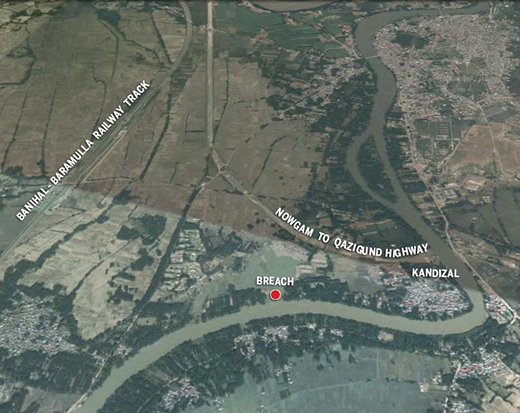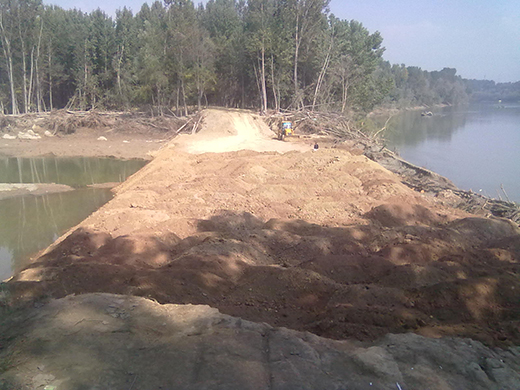The official blame game after recent floods has once again brought this godforsaken village called Kandizal into focus. But is Kandizal really worth all the blame, Safwat Zargar finds out

No people know floods as closely as people of Kandizal. For decades they have bore Jhelum’s fury and let Srinagar escape the worst. On September 4, gushing floods washed off Kandizal embankments and with it, three days later, sank the legacy of saving the city.
Reason: railway embankments and under construction Bye-pass connecting south Kashmir to city. Locals say, both acted as a shield that didn’t let the water, like in past, to swirl across thousands of kanals of paddy fields and plantations. History shows, in order to save Srinagar, breaches at Kandizal during floods would stream water towards vast fields and reach as far as Sumbal Sonawari in North Kashmir, but not the city. This year, reverse happened.
“Srinagar will continue to drown,” warns Abdul Hameed, a local of Kandizal. Fifty-five-year old Abdul is speaking from his experience, “I agree that floods of this magnitude hadn’t come before, but the mechanism of diverting overflowing Jhelum at Kandizal before entering the city won’t work now. It’s because around 30-40 feet high railway bunds and high dykes created by under-construction new highway from South Kashmir-Nowgam sends water back toward Jhelum”.
Interestingly, during floods, at many places, the 136-kilometre railway track – running from Banihal in south of the valley and cutting through Anantnag and Pulwama districts before reaching Srinagar and then Baramullah in North – became an open sky and high altitude shelter for many people escaping floods.
Abdul’s analysis gain weight if floods of September 7 are seen retrospectively! Post floods, many experts opined that railway lines laid on elevated bunds cutting across the peripheries of Srinagar city towards Pulwama and Anantnag had created block for water to move further. In case of Kandizal, the under-construction highway intersecting Jhelum added to the worse; by reverse flow of water toward Jheulm.
Even the state government acknowledged the blockage of water by as a result of railway lines and new road. During a press conference on September 29, Commissioner/Secretary Flood Control Department, Pawan Kotwal said “since the breach had taken place near Kandizal, we contemplated that water will be absorbed by basin from Kandizal to Lasjan. But the track and the highway prevented spread of water which led to increase in the level of flood water.”
In the press conference, he also put to rest the blame-game surrounding Kandizal embankment, by admitting that “on September 4, when the water level increased drastically in river Jhelum, it breached the Kandizal embankment on Srinagar-Jammu highway.”
On the banks of snaky Jhelum near Galandhar Pampore, Kandizal is a silent village of farmers and labours, nestled in the womb of an acute-angled curve of the meandering river. A sparsely populated village of about 200 households, Kandizal is accessible by two ways – a patch of rickety road slicing through paddy fields from old Pampore-Shopain highway or through a locally arranged free boat service from Galandhar side. Mostly, it is the shorter boat ride, villagers and visitors prefer. “Nobody blasted off Kandizal. All this Army and government accusing each other of breaching Kandizal is hoax,” says Fayaz Ahmad, Sarpanch of the village.
Fayaz clearly remembers the evening of September 4, exactly three days before half of the Srinagar would be buried under water. “Neither Army nor any government official was present. We were already in the process of plugging small craters in Kandizal embankment since September 2. For three days, thousands of youth from Kandizal and other neighbouring villages volunteered to strengthen the embankment. It was totally a local effort,” he says.
Did you approach flood and irrigation department? Fayaz recalls his experience with the Executive Engineer Flood Control Division Kakapora, Mohammad Altaf Koul. “During the continuous rainfall for the three days, I called him many times and personally visited his office. He didn’t do anything. His reply was: “Mere paas kuch nahi hai. (I don’t have anything to help you with).”
Turned down, instead, Fayaz took help from a private construction firm building the highway. The firm gave him two bulldozers and four thousand bags, but it was too little. At 3 PM on September 4 (Thursday) furious water began to flow underneath the weakest point of the embankment. After few hours, floods washed off a large chunk of around 30 feet high Kandizal dyke. By night, not only Kandizal but the adjoining villages including a portion of Saffron town were under water. The two dykes encircling and protecting the village from backside also disappeared. “It was all water. People began to flee. Many couldn’t save anything at all,” Fayaz says.
According to locals, there were four breaches all along the embankment as a result of roaring Jhelum near Kandizal village; three from Kandizal to Khadermoh and one from Kandizal to Pampore. The longest breach was of around 150 metre near Khunn-E-Khodi-Her. Other breaches stretched up to 100 metres maximum.
When Kashmir Life visited the village, a bulldozer and hundreds of trucks laden with soil were on the job to fill the breach. “The breach has almost eaten up four thousand trucks of soil till now,” says Khurshid Ahmad, a local contractor. Khurshid has got the contract to fill up the breaches near Kandizal created by September floods. “It will take some five-six thousand more trucks to make it like before,” he informs. The remaining breaches have been already plugged.
Khurshid, who is in his mid 40s, however, warns about the dangers of floods in future. Like Abdul, he too believes the purpose of Kandizal has long ago vanished. “In past, authorities would blast off Kandizal embankment so that high-flowing Jhelum could be diverted to swathes of unpopulated marshy land and paddy fields. Now, two giant embankments sit in the middle of areas that used to be Jhelum’s course during floods.”

Khurshid blames “poor planning and lack of coordination among various government departments for the mess.” He offers some solutions: a flyover from Kandizal to Pampore-Shopain highway instead of on-surface road and dismantling of railway line paralleling Kandizal. “Can’t government construct bridges for trains to ply and leave out the ground open?” he asks, his tone belying the plausibility of his suggestion.
Recalling floods, villagers say nobody came to their rescue for the nine days they remained trapped in more than 10-feet water. Sarpanch Fayaz says seventeen families became homeless; the remaining structures have developed cracks. Floods have hit on livelihood front too.
Manzoor Ahmad Reshi, a local, says he has lost everything. Floods submerged his source of livelihood – a poultry farm. “There were around 2000 birds in my farm. After floods, I took out only the rotting carcasses,” he says.
Manzoor says he doesn’t know how to live now. “Compensating for shelter is not enough. Living hungry inside a safe house doesn’t mean we are satisfied. There should be a package for livelihood too.”
Villagers’ whose houses collapsed during the floods have received the compensation of 75000 rupees; those with cracks have received the first instalment of 5000 rupees, Fayaz informs. Affected laugh out at the government’s assessment of damage. Some question a Patwari’s credentials for estimating the loss.
“Today, a mason and his troupe of workers cost around 6000 rupees a day. These 5000 rupees is a nail on the wound,” remarks an old man, refusing to disclose his name.
While walking on the banks of Jhelum near Kandizal, one comes across the ghastly devastation caused by the angry Jhelum. Huge chunks of displaced land including the several hundred feet tall poplar and willow trees lay like a fallen giant. As for now, what remains is the gap, large enough to etch in the memories and horrors of Kashmir.
Over the years, cropping up of more than a dozen stone crushers and macadam plants have attracted manpower from the adjoining villages. In Kandizal, most of the villagers derive their livelihood from these plants. Rice cultivation is another occupation synonymous with the village, but it is seasonal. Sand extractors from neighbouring areas labour in Jhelum, daily, making them one of the prime sources of raw material suppliers to the construction industry in South Kashmir. Echoes of the manual sand extraction, giving much needed depth to Jhelum, resound in the village. Aware of government’s failure in dredging the river, locals, though not involved directly with it, demand that government should encourage sand extraction on mass scale.
The day Kashmir Life visited Kandizal, police, near Budgam, had stalled several trucks of soil meant for filling Kandizal breaches.
A local, Mohammad Subhan, is angry about the freezing of trucks laden with soil for Kandizal by police. “I don’t understand what this government is up to? On one side, it wants breaches plugged on priority, while on the other side they aren’t allowing trucks to move. It’s a mess,” he laments.
Seventy-year old Ghulam Ahmad Sheikh, a farmer, says he has not seen floods of such intensity in his life. Every year, Ghulam’s farm would yield around 70 quintals of rice and a huge quantity of fodder.
“This year,” he says, “there’ll be nothing.”















